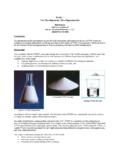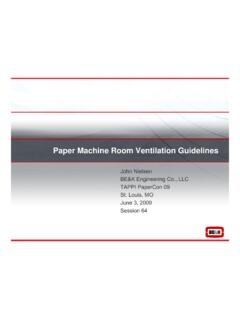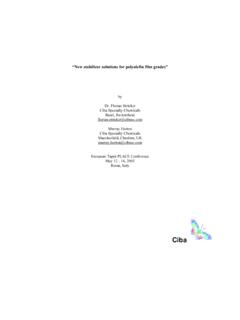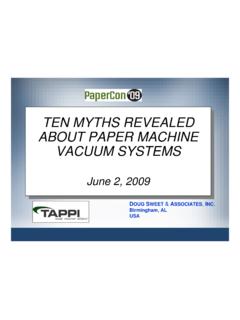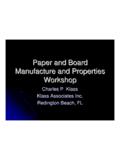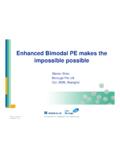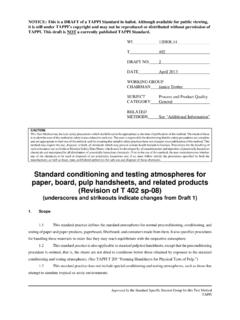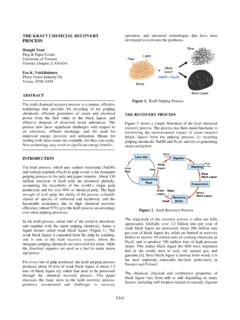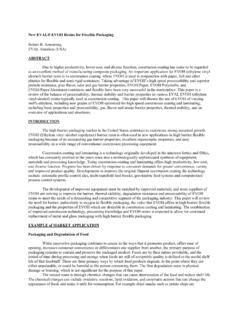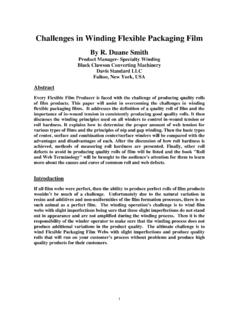Transcription of Flat Die Extrusion Cast Film, Coating & Laminating - TAPPI
1 Flat Die ExtrusionCast Film, Coating & LaminatingAndy ChristiePrincipal EngineerOptex Process Solutions, Consumer Packaging Solutions for Barrier Performance CourseOutline Flexible Packaging Structures Flat Die Co- Extrusion Film Formation Web Handling, Conditioning, Winding TroubleshootingWhy Flexible ? Serves multi-functions Containment Portion Protection Barrier Presentation Promotion Identification Instruction Convenience Preparation Security Tamper Evidence Branding - RecognitionWhy Flexible ? Performance by design Mono Layer Film Co-extruded Film Coated / Metalized Film Lamination Paper / Film / Foil / AdhesiveExamples CPP Single Candy Twist Wrap HDPE/Sealant Dry Mix / Cereal PP/PP+Recycle/LDPE Cheese Film LDPE/Tie/Nylon/Tie/LDPE Meat Pack BOPET/Nylon/Ionomer Frozen Veg Paper/LDPE/Foil/Sealant Dry Mix BOPET/LDPE/Foil/Sealant Condiment PP/Tie/EVOH/Tie/PP Juice BOPET/LDPE/metalized/Sealant Coffee LDPE/Board/LDPE/Foil/EAA/LDPE/Sealant - JuiceWhy Cast Film?
2 Optical characteristics Production capacity Gauge uniformity Unit conversion costs Structure versatility (feedblock)Why Extrusion Coating ? Substrate versatility Production capacity Print protection Unit conversion costWhy Extrusion Laminating ? Substrate versatility Production capacity Print protection Unit conversion cost Ultimate barrier / package performanceFlat Die Co- Extrusion Common process and arrangement for cast film, Extrusion Coating , and Extrusion Laminating Differences in materials processed, typically lower MI for cast film Differences in die manifold geometry, typically T-slot for Extrusion Coating & Laminating vs coathanger for cast filmCommon Film FormingVacuum BoxAir KnifeFlat Cast FilmMelt Embossed Cast FilmExtrusion CoatingCoextrusion CoatingCoextrusion LaminatingTypical Cast Film Co- Extrusion ArrangementPhoto Courtesy SMLCast Film DiePhoto Courtesy EDIT andem Extrusion LaminatingPhoto Courtesy Sung An MachineryCoex Coating Moveable ExtruderPhoto Courtesy Sung An MachineryCoex Coating Fixed ExtruderPhoto Courtesy SMLT ypical C/L DiePhoto Courtesy EDIE xtrusion Laminating LineMulti Function Lab LinePhoto Courtesy Dr.
3 Collin GmbHMulti Function Lab LineBasic Extrusion System Resin Handling & Blending Single Screw Extruder Polymer Filtration Pressure Control Polymer Flow Pipes Feedblock Single Manifold DieResin Handling & Blending Rail Car Unloading Storage Silos, Day Hoppers Pneumatic Conveying Resin Drying Blenders Volumetric Gravimetric Additive Feeders Surge Hoppers Magnetic FiltersResin Handling SystemSingle Screw Extruder Fabricated Base Drive Motor Gear Reduction Unit w/ Thrust Bearing Cooling Jacketed Feed Throat Bimetallic Barrel Hard Faced Feedscrew Barrel Heating & Cooling Instrumentation Drive & Temperature ControlsBasic Extruder SchematicBaseBlowersBarrel w/ heaters & coversFeed ThroatMagnetHopperSpeed ReducerDrive MotorDieScreen,Valve &PipesFeedscrewPolymer Filtration Manual Screen Changers Slide Plate Screen Changers Continuous Screen Changers Dual Slide Plate Rotary Advancing Screen Extended Area FiltersPressure Control Orifice Plates Back Pressure Valves Polymer Melt PumpsPolymer Flow PipesCompuplast VEL CalculationFeedblocks - Function Arrange polymers in structure order Reshape the polymer streams for combining Velocity compensation Viscosity compensation Join the polymers togetherFeedblocks - Styles Dow Patent Insert style Externally adjustable typeDow Style FeedblocksEgan designDow Style FeedblocksBlack Clawson designInsert Style FeedblockEDI designExternal Adjustable FeedblockPhoto s Courtesy Cloeren Adjustable FeedblockVerbruggen designCast FilmSimulation Using Compuplast VELE xtrusion
4 CoatingSimulation Using Compuplast VELCo- Extrusion Issues Encapsulation Viscosity mismatch Interface Instability Relative velocities Interface shear rate Shear viscosity Elongational viscosity ENCAPSULATON WHEN THE RELATIVE VISCOSITY BETWEEN THE POLYMERS ARE LARGE THE LESS VISCOUSPOLYMER WILL SURROUND THE MORE VISCOUSR esin Encapsulation Problem Migration and Encapsulation PhenomenonStart of flow through pipeEnd of flow through pipe A encapsulates B Resin AResin BThe material seeks the path of minimum resistance and pressure drop. The degree of interfacial distortion (migration and encapsulation) depends on the magnitude of the viscosity difference, shear rate and length of the flow path. Low viscosity material flows around high viscosity Block Exit Profile Resin A 20% EVA Resin B 80% LLDPEABDie Exit Profile Resin A 20% EVA Resin B 80% LLDPEABE ncapsulation Die FlowWeb Cross SectionFrom Feed BlockVISCOSITY COMPENSATIONF eedblock geometry can be designed to shape the flow of the polymer at the feedblock exit to compensate for the viscous encapsulation phenomenonFeedblock ProfilingDistribution Pin ProfilingDistribution Pin FunctionVideo ModelCourtesy Cloeren IR Scan 315310306301297292288 Die Bolt Position31431231030830530330129929729429 2290288IR Scan Showing Response To Feedblock AdjustmentInstantaneousResponse315310306 301297292288 Die Bolt Position31431231030830530330129929729429 2290288 Interface InstabilityResponse due to critical stress at interface Velocity at combining
5 Shear rate at interface Relative viscosities Shear ExtensionalInterface Instability Applesauce Fuzzy Edges Sharkskin Zig-zag Orange peelVelocity At CombiningVelocity Compensation3D Simulation Courtesy Compuplast Viscosity EffectsSimulation Using Compuplast VELT emperature EffectsSimulation Using Compuplast VELO utput ( Velocity) EffectsSimulation Using Compuplast VELTo Reduce Instabilities Increase skin layer thickness Via output (actual) Via temperature (effective) Reduce skin layer viscosity Increase the die gap Decrease total output Match combining velocities (edges)Film FormingVacuum BoxAir KnifeFlat Cast FilmMelt Embossed Cast FilmExtrusion CoatingCoextrusion CoatingCoextrusion LaminatingMajor Factors in Extruded Film Properties Extrudate temperature Die gap Air gap (Quench Point, Nip Point) Draw ratio Output Chill roll temperature Air knife, vacuum box, nip loadIncrease Melt Temperature Decrease density Increase Raise gloss Lower haze Lower tensile strength Reduce viscosity Decrease neck-inDie Slot CalculationsDS=FW + (2 x N) + (2 x E) + RDS is normally 6 to 24 greater than.
6 DS= Die slot (in)FW= Finished width (in)E= Edge trim (in)R= Randomization (in)B= Bleed trim (in)N= Neck-in per sideDecrease Die Lip Gap Increase die swell Increase roughness Increase draw orientation Increase haze Decrease gloss Decrease impact strengthIncrease Air Gap Slower cooling for more crystallinity Increase density Increase Increase stiffness Increase haze Decrease Reduce impact strengthMethods of ImpingementVacuum Box: negative pressure Contacting non-contacting sealStatic & Air Pinning: positive pressure to overcome film stresses and maintain edgesMethods of ImpingementAir Knife: positive high pressure additional cooling 3 degrees of adjustmentStatic & Air Pinning: positive pressure to overcome film stresses and maintain edgesPhoto Courtesy Cloeren of ImpingementSoft Box: Positive low pressure, large film area Additional cooling 3 degrees of adjustment Easy set up & removalPhoto Courtesy Cloeren Film Unit Chill roll - DSSF Extrudate temp Chill roll finish: matte and mirror Plate out removal Secondary cooling roll - DSSF Auto profile control Frost line adjustment Idler rollsMelt Emboss Film System Extrude into nip High pressure nip Embossed pattern on rubber roll Water pan &/or fountain Squeegee roll prevents carryover MDO for breathabilityPhoto Courtesy BC-EganEmboss Pattern Set In NipPhoto Courtesy BC-EganExtrusion LaminatorPhoto Courtesy Sung An MachineryProcess Water System Divided water tank Process loops: high flow, low delta T chiller loop.
7 Low flow, high delta T Monitor temp at exit Modulating valveIncreasing Quench Temperature Increase quench time Increases crystallization Increase density Increase stiffness Increase barrier Decrease optics Decrease Decrease impactWater Flow Calculations(Cast Film)GPM=(( (T2-T1))/(TRWx500)) (GPMxTRWx500)/( (T2-T1) )Where:GPM= Gallons per minute of cooling mediumQ= Total extruder output (lb/hour)T2= Melt Temperature (F degrees)T1= Strip temperatureTRW= Temperature rise of the cooling water through the chill roll(3 degree F normally used for LDPE, 1-2 degree F normally used for PP & Nylon) chiller Sizing CalculationsTon = ((Q x x (T2-T1)) / 12000) x = (Ton x 12000) / ( x (T2-T1) x )Where:Ton = tonnage of refrigeration required or available at 50 degree FQ = Total extruder outputT2 = Melt temperature (F degree)T1 = Strip temperature (F degree)Web HandlingProvide Isolation Of Tension Between Various Process Functions From Winding TensionFor Web Tension Isolation Must Have Grip On Web!
8 Tension Terms80 Unit Tension = 2 PLIT otal Tension = 80 lbsPer 1 Width == 2 Pounds Per Linear Inch (PLI)80#40 80 Figure 1 Figure 2 Typical Tension Values for FilmsFILMSTENSION to to to to to to to Dancer Tension ControlVentMotorDancerControlI to PConverterAirCylinderAirRegulatorDancer PositionSensorDancer AssemblyPhoto Courtesy Fulton MachineryTransducer Load Cells Used instead of a dancer Strain gauge senses tension Direct readout of tension Precision roll balance for best accuracyTension Zones Between driven sections on the line Different tensions can be run between sections Must have a grip on the web (see next slide) Usually separated with a nip Isolate key sections: Primary unwind Treater Laminator Interleaf Unwind WinderPull RollsNip Pull RollSuggested Nip = 3 x TensionCheck Loaded DeflectionPivotCylinderOutgoing Nip S Wrap Pull RollT1/T2= f(wrap, friction) S Wrap Will NotIsolate Tension WavesNip Pull RollsRubber Covered RollsFigure 6 Figure 7 Differential TensionOutgoing TensionT2 = 1 PLIT1 = 1 PLII ngoing TensionT1 = 2 PLII ngoing TensionT = T1 T2=1 2T = 1 PLI (Regenerating)T = T1 T2= 2 1T = +1 PLI (Motoring)Figure 8 Figure 9 Outgoing TensionT2 = 2 PLIWeb Handling Basics Rolls in contact with the web must be in proper alignment.
9 Non-driven rolls should turn as friction free as possible. There are times when idlers may be covered to provide turning Rolls Convey product Driven or non-driven Live & dead shafted Material: Aluminum- low cost, Steel- high durability, Composite- less weight, low inertia, less durableFinish Flash chrome plating - reduces corrosion and wear Anodizing - reduces corrosion and wear Vent grooving - reduces air entrapment and wrinkles Negative crown - reduces wrinkles Plasma Coating - increase traction and releaseWeb Spreader RollsSmooth web out at entry into critical machine sections: pull rolls, coater, laminator, : Bowed rolls, fixed & variable Reverse crowned rolls Herringbone grooved spreader rolls (foils) Flex spreader rollsWeb Guiding Distributes gauge bands Aligns webs for Coating or lamination Z or U configuration Normally floor mountedUnwinder Continuously unwinds web products, roll to roll transfer by an automatic cut and past system Dancer for tension control and compensation Regenerative drive for speed match and tension hold backUnwind w/ Auto SpliceLaminate (Sandwich) UnwindPhoto Courtesy Sung An MachineryRoll Prepared To SpliceWinders Continuously winds film by means of automatic transfer roll changing In-line slitting and trim removal (Film) Gap or contact Shafted or Shaftless Transfers with or without adhesivesWinder w/ Auto TransferWinder w/ Auto TransferSurface Winder (Reel)
10 Photo Courtesy BC-EganFilm Winder TransfersStationary KnifeTAPEKNIFE Tape core Index to contact No knife fire Dual direction No speed limitsStatic TransferCONDUCTIVE PLANE(CORE SHAFT)KNIFESTATIC BAR No tape required Index to charge core No knife fireSpeed limitations (500mpm)Film Winder Trim Haul-OffPhoto Courtesy SMLHigh Speed Film WinderPhoto Courtesy SMLT roubleshooting 101 State the problem Identify possible solutions Hypothesis Test the hypothesis Evaluate the test results Implement corrective action or Repeat the processState the problem Write it dow
